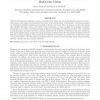Free Online Productivity Tools
i2Speak
i2Symbol
i2OCR
iTex2Img
iWeb2Print
iWeb2Shot
i2Type
iPdf2Split
iPdf2Merge
i2Bopomofo
i2Arabic
i2Style
i2Image
i2PDF
iLatex2Rtf
Sci2ools
115
click to vote
DPHOTO
2009
2009
Interleaved imaging: an imaging system design inspired by rod-cone vision
Under low illumination conditions, such as moonlight, there simply are not enough photons present to create a high quality color image with integration times that avoid camera-shake. Consequently, conventional imagers are designed for daylight conditions and modeled on human cone vision. Here, we propose a novel sensor design that parallels the human retina and extends sensor performance to span daylight and moonlight conditions. Specifically, we describe an interleaved imaging architecture comprising two collections of pixels. One set of pixels is monochromatic and high sensitivity; a second, interleaved set of pixels is trichromatic and lower sensitivity. The sensor implementation requires new image processing techniques that allow for graceful transitions between different operating conditions. We describe these techniques and simulate the performance of this sensor under a range of conditions. We show that the proposed system is capable of producing high quality images spanning ph...
Related Content
| Added | 17 Feb 2011 |
| Updated | 17 Feb 2011 |
| Type | Journal |
| Year | 2009 |
| Where | DPHOTO |
| Authors | Manu Parmar, Brian A. Wandell |
Comments (0)

